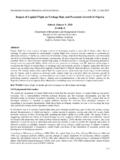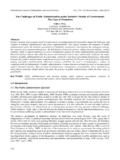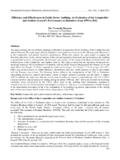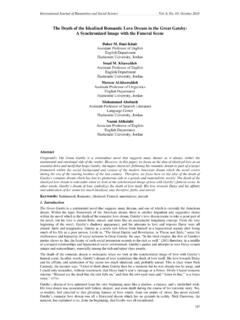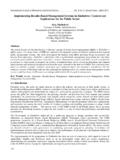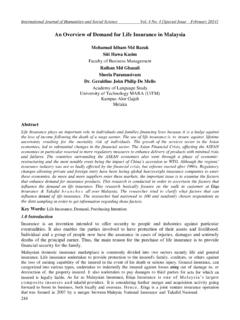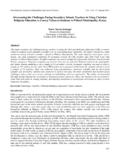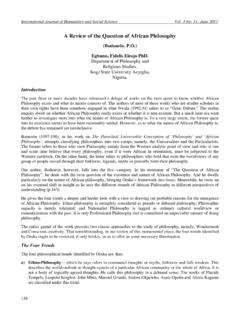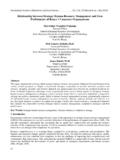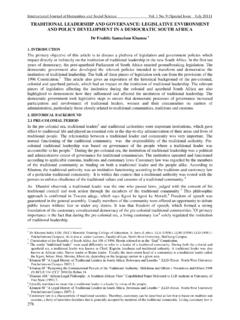Transcription of Systemic Review of the Prevalence of Speech and …
1 International Journal of Humanities and Social Science Vol. 5, No. 5; May 2015 130 Systemic Review of the Prevalence of Speech and language disorders in nigeria Nellyzita Nwosu, PhD, CCC-SLP New York City Department of Education Jackson Heights NY 11372 Abstract There is a paucity of research on the Prevalence of Speech and language disorders in nigeria . Results of the few studies that have investigated the Prevalence of Speech and language disorders in nigeria reveal the Prevalence of Speech impairment to be 8-30% of individuals in nigeria who present with communication deficits. Limitations in the Prevalence studies that have been conducted in nigeria are that 1) the studies were conducted on individuals who have been identified as having communication deficits or who have expressed concerns with their communication skills, 2) most of the Prevalence studies in nigeria provide reports on Speech and hearing disorders with less information on language disorders , and 3) many of the evaluators were either audiologists, doctors or other professionals who were not trained to diagnose Speech and language disorders .
2 Prevalence studies that compare the number of individuals with Speech and language disorders with the total population within an area are needed. The finding of the studies can provide information as to address the percentage of the population that may benefit from Speech and language services. Keywords: Prevalence , Speech , language , nigeria 1. Introduction Few studies have investigated the Prevalence of Speech and language disorders in nigeria , the most populated country in Africa and the seventh most populated in the world (The World Bank, 2015). Prevalence is the proportion orpercentage of cases in a given population at a specified time within a normal rather than clinical population (Law, Boyle, Harris, Harkness, & Nye, 2000, p.)
3 166). A Speech and language disorder refers to an impairmentin a person s articulation of Speech sounds, fluency, voice, comprehension and use of spoken, written or other symbol systems (American Speech - language -Hearing Association [ASHA], 1993). 2. Prevalence in Developed Countries Several studies have investigated the Prevalence of Speech and language disorders in developed countries such as United States, Canada, United Kingdom and Australia (ASHA, 2015).Law et al. (2000)performed asystemic Review of the literature related to screening for Speech and language delays conducted in the United Kingdom. Their resultsrevealed the Prevalence of Speech and language disorders to be 2-25% of children with a median Prevalence of (Law, et al.
4 , 2000). McLeod & Harrison s (2009) study of Australian children showed that 16-22% of Australian five-year-old children would be identified with Speech impairment on formal assessment tests. A study of Canadian children revealed a Prevalence of language impairment to be (Beitchman, Nair, Clegg, & Patel, 1986). The 2011 South African Census (Statistics South Africa, 2011) reported 6% of South Africans as having a Speech and language the United States, Tomblin, et al., (1997) reported the Prevalence of Speech and language disorders in children to be Similarly, McQuiston&Kloczko (2011) reported5-8% andPinborough-Zimmerman,et al.
5 , (2007) reported of school-age childrenhave Speech and language delays or disorders that may be associated with subsequent learning, socioemotional, or behavioral problems. Results of Prevalence studies in developed countries may vary as a result of methodological procedures, sources of information ( ,direct face-to-face assessments, parental reports, teacher reports), and differences in the definition of Speech and language impairment and severity (ASHA 2015; Law, et al., 2000; McKinnon, McLeod, & Reilly, 2007; McLeod & Harrison, 2009). ISSN 2220-8488 (Print), 2221-0989 (Online) Center for Promoting Ideas, USA 131 3.
6 Prevalence in nigeria In the case of nigeria , studies have investigated the individuals who have been identified as having Speech and language difficulties to determine the specific communication disordersthey exhibit. Somefun, Lesi, Danfulani&Olusanya(2006) conducted a study at Lagos University Teaching Hospital with children between ages six months and fifteen years with communication disorders in nigeria . Findings revealed that out of their 184 participants, hearing impairment was documented in 65%, Speech disorders in 30%, rhinolalia (a nasal quality in Speech ) in 2%, and stuttering in 2% of the children. Of those with hearing impairment, 70% were considered to have delayed Speech and language skillsand of those with Speech disorders , 79% had specific language impairment(Somefun, et al.)
7 , 2006). Aremu, Afolabi, Alabi, &Elemunkan (2011)also investigated individuals with Speech and language difficulties. They studied146 children and adultswho were referred for Speech and language therapy at theUniversity of Ilorin teaching hospital in North Central than half (58%) of the patients had a diagnosis of deaf-mutism, defined as the inability to speak. Twenty-one percent were diagnosed as having delayed Speech development, 4%slurred Speech pathology, 13% impaired Speech , 3% stammering/stuttering and 1% with aphasia. At the University of nigeria Teaching Hospital in Enugu, Iloeje&Izuora (1991) studied 965 children with neurological disorders over a three-year period (1985-87) and found with Speech impairments.
8 Other studies have looked into the Prevalence of dysfluencyand autism in nigeria . Nwokah (1988) studied disfluentbilingual Igbo/English in Anambra State nigeria and reported that of Nigerians were individuals who , Ebigbo, &Ubochi (2012) investigated the Prevalence of autism spectrum disorder (a disorder that involves deficits in communication)amongforty-four Nigerian children with intellectual disability. Results revealed 11%of the children studied were diagnosed with childhood autism. 4. Limitation of Prevalence Studies in nigeria Overall, results of the studies reveal the Prevalence of Speech impairment to be 8-30% of individuals in nigeria who present with communication deficits.
9 Most if the Prevalence studies that have been conducted in nigeria were conducted on individuals who have been identified as having communication deficits or who have expressed concerns communicating. nigeria needs Prevalence studies that compare the number of individuals with Speech and language disorders with the total population within a specific is insufficient information on the Prevalence of Speech and language disorders among children within the school system in nigeria . Most of the Prevalence studies in nigeria report on the percentage of individuals with Speech and hearing disorders with less information on the percentage of individuals with language disorders .
10 The few reports on Prevalence of language disorders often grouped language disorders and Speech disorders together, labeling them both as Speech disorders . The studies also lacked information on the specific types of Speech sound disorders ,either articulation or phonological disorders , exhibited by the participants. Theyalsoincluded the causes of the Speech sound disorders ( , hearing impairment) rather than the type of Speech sound disorders . In the studies, many of the evaluators were either audiologists, doctors or other professionals who were not trained to diagnose Speech and language disorders . There is a national shortage of Speech - language pathologists in nigeria (Ayo-Aderele, 2013; Nwanze, 2013) so Nigerians report to medical professionals ( , pediatricians, otolaryngologists, psychiatrists) to treat and advise patients and caregivers regarding Speech and language concerns.
